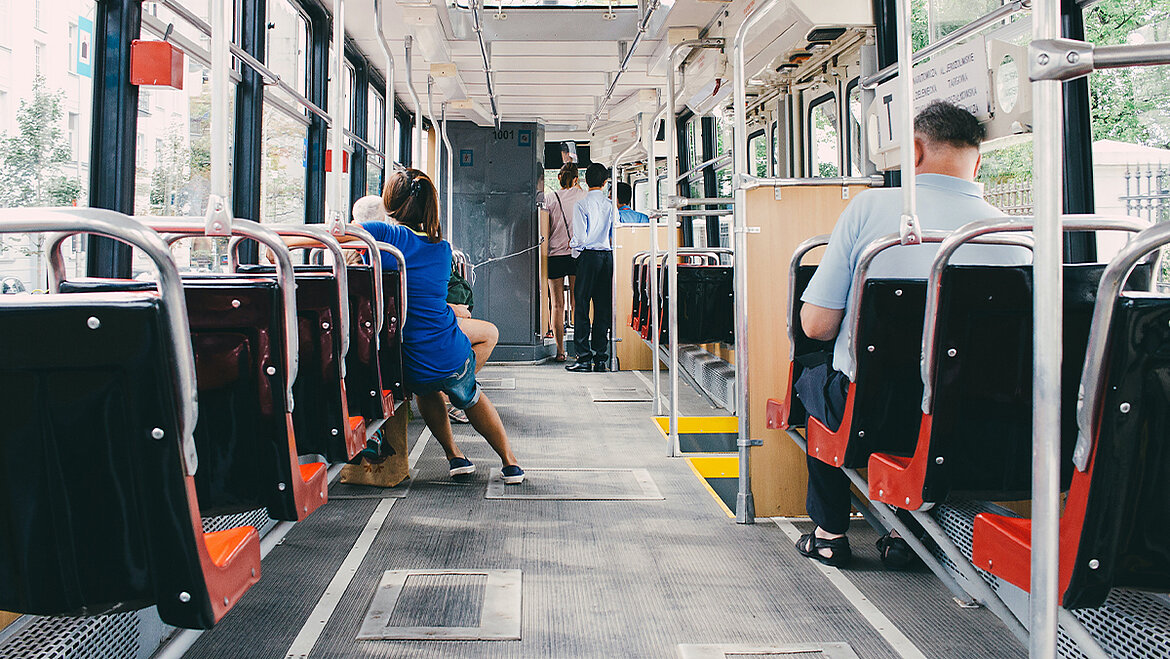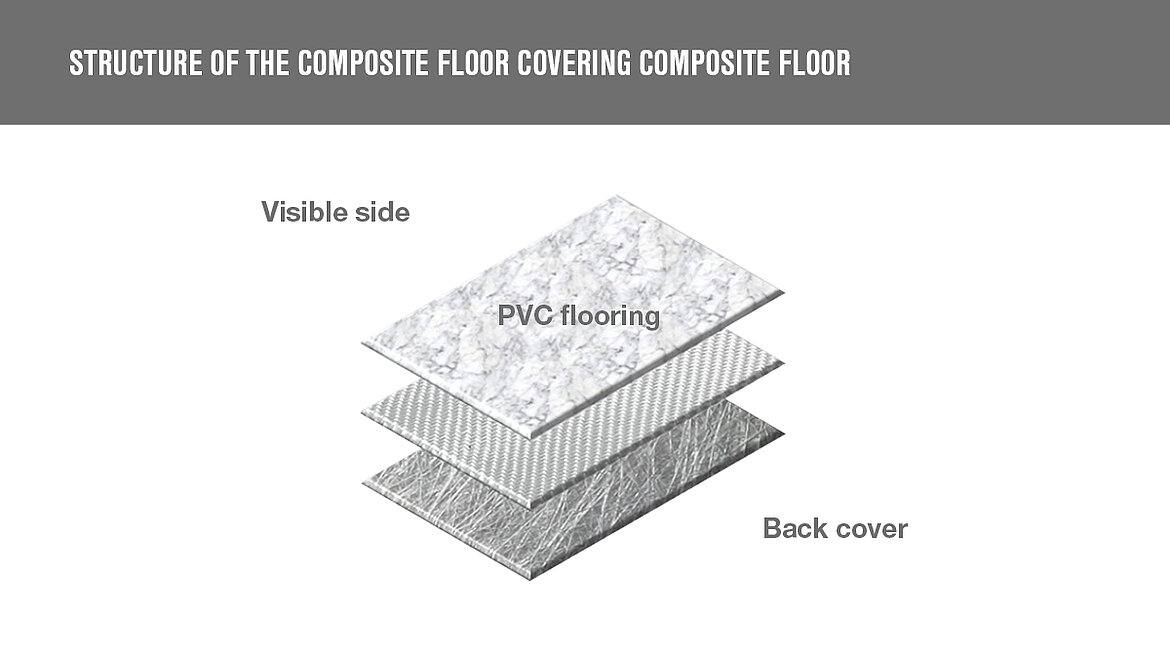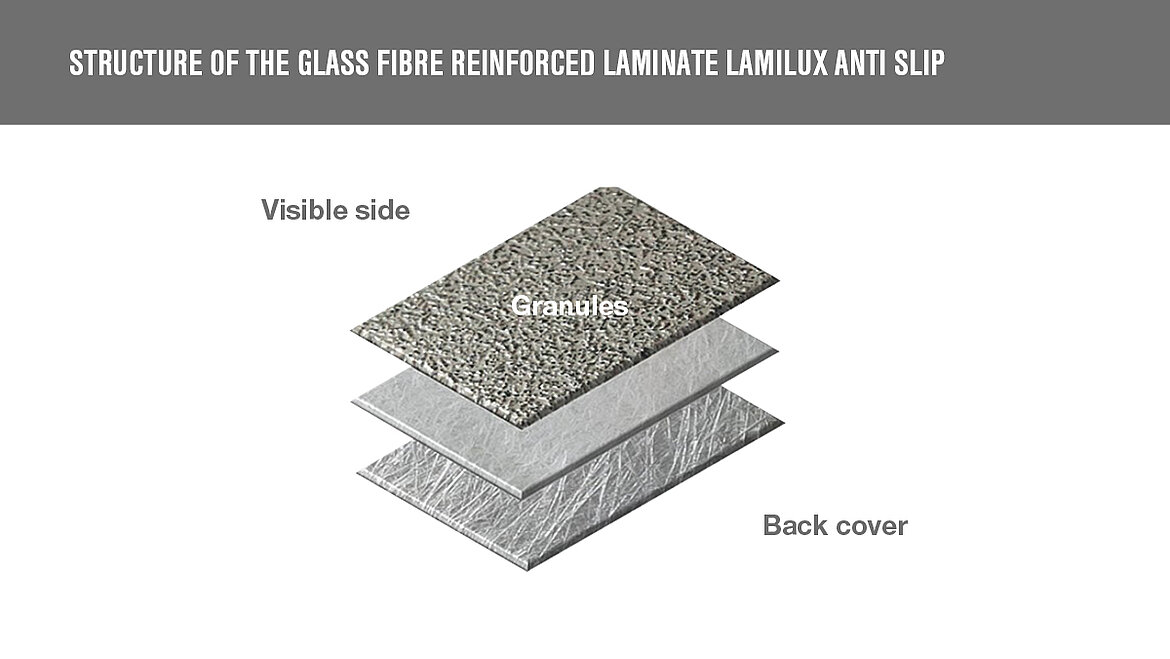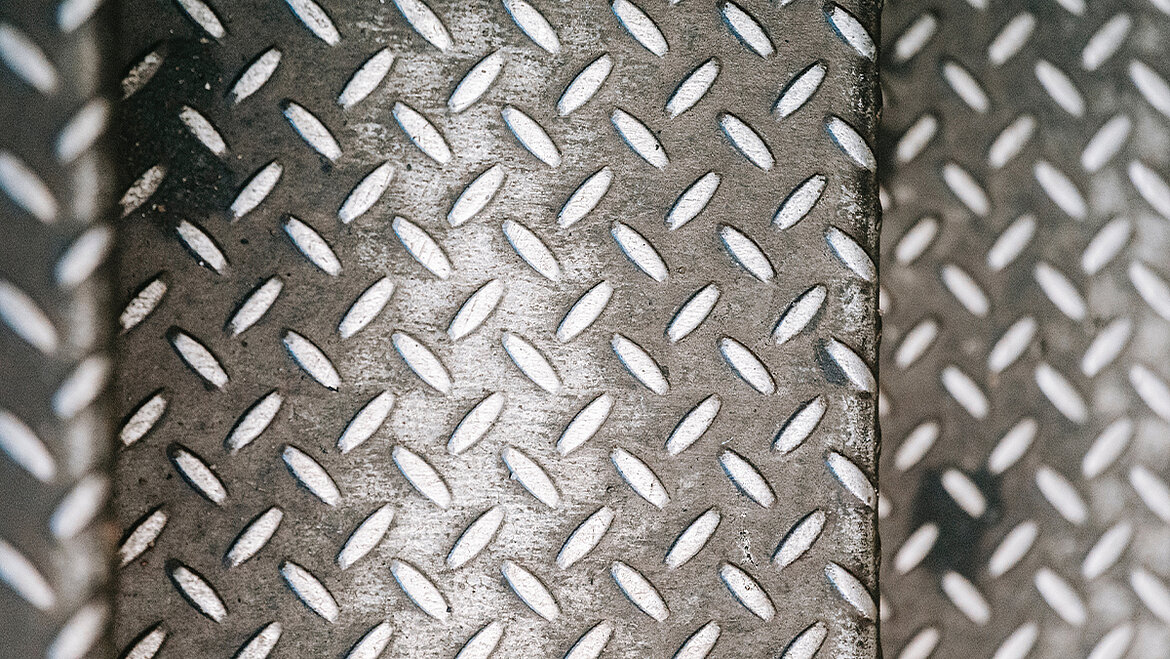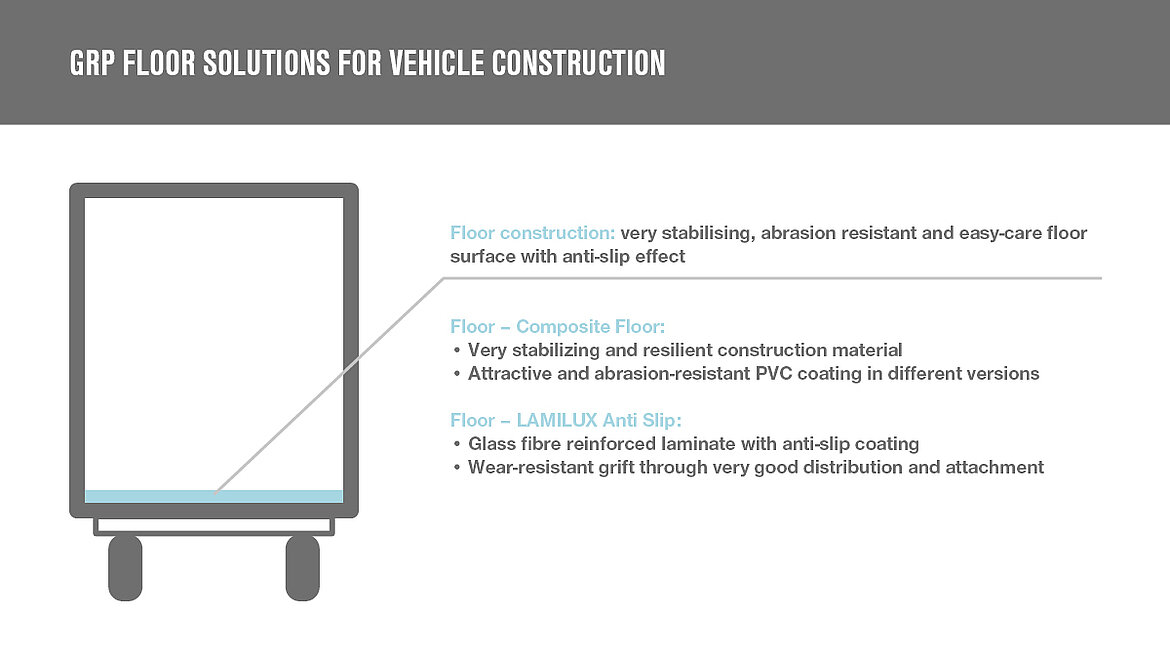Floor panels provide a solid foundation
People get in and out, luggage or goods slide around and moisture and stones are also commonplace: A vehicle floor is subjected to a lot of stress and a range of influences. This is why vehicle manufacturing requires weatherproof, robust, easy-to-install, but also visually appealing components.
Depending on the vehicle type, requirement profile and intended use, different floor panels provide appropriate floor solutions in vehicle manufacturing.
But one thing is certain for all vehicles: A floor panel is a part of the floor construction, supports it significantly and is essential for the stability of the vehicle, as it forms the solid foundation of the vehicle. Without a floor panel, the floor in the interior of a bus or caravan and the loading area of a commercial vehicle or delivery vehicle can quickly become damaged.
Therefore: Equipping the vehicle with a floor panel extends the durability of life and helps to avoid expensive repairs.
Different materials are used for floor solutions in vehicle manufacturing, and each offers different advantages and disadvantages. The most commonly used floor solutions are made of wood, aluminum and glass fibre-reinforced plastics (GRP). But what are the advantages of each flooring solution? We have compiled a summary of all you need to know about floor solutions in vehicle manufacturing.
Floor solutions with plywood panels
One of the most well-known and proven materials for a floor panel is the natural material wood. To be specific, plywood panels are most commonly used in floor systems in vehicle interiors. The panels made of compressed wood are used in particular as cargo space protective flooring for box-type vehicles, trailer floor panels, but also as a highly stressed floor panel for platform bodies and heavy commercial vehicles. Manufacturers are also increasingly using plywood panels for the interior finishing of transporters. But why is this? And are there any reasons against the use of plywood panels in the floor construction? These are the pros and cons of wooden floor solutions:
Advantages of wooden floor solutions:
- Wooden floor solutions are environmentally friendly, as the material is a naturally renewable raw material. As plywood is a natural product, it can also be recycled at the end of its service life. Wooden floor panels offer a wide range of design freedom and a natural, aesthetic appearance.
- Plywood is relatively durable, but only when at least three layers of wood are thinned out and glued together.
- Plywood is also a very economical material, as its acquisition costs are lower compared to other materials.
Disadvantages of wooden floor solutions:
- While plywood is based on the natural product wood, it can now be better and frequently recycled, but not in all cases. Because plywood panels are glued together, this significantly influences the recyclability of the product.
- Wood is a natural material that expands and contracts due to moisture, temperature fluctuations or changes in humidity. Over time, such fluctuations can cause gaps and cracks over time.
- Untreated wood is not water-resistant. In the worst case, it can become mouldy and offers little protection against external influences such as scratches, moisture or UV radiation.
- Keyword: UV radiation. Depending on the species, the wooden floor panel may lose its colour over the years as it reacts to UV rays. Exceptions here are special floors that are treated with special processes and therefore remain colour stable.
- Wood is not a uniform building material because every tree is different. Therefore, reproducibility issues arise. After all, the automotive industry demands a very high level of reproducibility exceeding a hundred thousand units. In order to compensate for the irregularities in the natural material wood, laminated plywood is usually used. The layered characteristic improves the strength of the floor panel, but makes the wood porous and susceptible to water damage if the layers develop leaks over time and water penetrates between the layers, causing the floor panel to swell.
- The material wood is generally lighter than GRP or aluminium, but laminated wood panels in a comparable construction can be heavier than the two materials. This is why wood is not suitable for lightweight construction.
Floor solutions with GRP materials
The specific performance requirements of a floor are heavily dependent on the type of vehicle: Bus, caravan, truck or delivery vehicle are just a few of the different types. The main focus is not exclusively mechanical properties for all vehicles. Appearance also plays a part, such as when buying a caravan, for example. Floors must not only be stable, but also offer the possibility of different design options. This is where glass fibre-reinforced plastic floor solutions come into play. Compared to competing materials, GRP is a material that represents a light, stable and visually appealing floor solution. There is one single factor that speaks against the use of glass fibre-reinforced plastics in the floor of a vehicle: the price. Compared to wood or aluminium, GRP is more expensive concerning acquisition costs. However, these slightly increased costs pay off over the product life cycle.
GRP – all-round floor solution
In vehicle manufacturing, weight is the crucial factor. GRP scores highly here, as sandwich constructions with GRP save weight and thus enable an increased vehicle payload weight or reduced fuel consumption. Sandwich constructions are composed as follows: two outer face sheets, usually made of GRP, and a core material.
Such a weight reduction in sandwich panels is demonstrated by the composite flooring LAMILUX Composite Floor. Specific PVC top layers are directly applied to the GRP reinforcement with material bonding.
This means that GRP can be used directly as a top layer in sandwich construction, as the floor covering has already been applied. In addition, the continuous production process of LAMILUX Composites ensures a consistent connection of the floor covering to the GRP.
In this way, PVC peeling from the carrier material is no longer an issue and further processing becomes lean and problem-free. This reduces the vehicle's weight and saves time and money thanks to the streamlined production process.Despite its low weight, a floor panel must also have a high mechanical strength as well as good wear resistance.
LAMILUX Composites Floor scores highly here as well with its low weight combined with high mechanical strength, stabilization and load-bearing capacity.
Glass fibre-reinforced plastics also offer the possibility of special anti-slip system solutions for vehicle floors.
The manufacturer LAMILUX Composites is known for such anti-slip flooring combinations.
LAMILUX AntiSlip is a glass fibre-reinforced laminate which combines the excellent mechanical properties and resistance of glass fibre-reinforced plastics with an effective and abrasion-resistant anti-slip coating.
The anti-slip surface is particularly suitable for use in delivery vehicles or as a floor covering in commercial vehicles.
Bumpy rides are no longer an issue because the granular AntiSlip surface prevents parcels or luggage from slipping around and ensures that all transport goods arrive at their destination intact.
What advantages does GRP offer for lightweight construction and what role do value retention and safety through TÜV-certified quality play in this? Do you want to learn more about the potential of fibre-reinforced plastics? Then the LAMILUX Academy is the right place for you. In numerous exciting webinars, LAMILUX experts will inform you about everything you need to know about GRP.
Floor solutions with aluminium
Use of aluminium in the automotive industry has been increasing for several years: Car manufacturers are increasingly turning to aluminium to make their cars lighter. Aluminium is not only suitable for the bodywork, but also as a solid flooring solution in vehicle manufacturing. Aluminium floor coverings reliably protect the loading area against damage that can always occur in everyday life.
For high demands, such as heavy wear or stress on the floor, it is possible to clad the floor with ribbed aluminium sheet metal and thus achieve high-quality, special protection. The corrugated aluminium floor is made of an extra-hardened aluminium alloy, which is more resistant and also harder than raw aluminium.
Aluminium also impresses with its low weight. Incidentally, corrugated aluminium is so-called because of its corrugated surface, which has anti-slip properties thanks to surface structure. However, according to the motto “all that glitters is not gold”, aluminium floor solutions also have a few disadvantages.
Lightweight aluminium – the disadvantages
Although aluminium makes vehicles much lighter, aluminium production consumes a great deal of energy. Production is very energy-intensive and in no way environmentally friendly. This is due to the complex production process of aluminium. The raw material bauxite contains aluminium hydroxide, which is first released with a caustic soda solution and then transformed into aluminium oxide by heating. This is followed by a very energy-intensive step: Fused-salt electrolysis. This is where pure aluminium is obtained. A large amount of carbon dioxide (CO2) is emitted in aluminium production for vehicles.
Other disadvantages are the hardness and dimensional stability of aluminium. These often leave much to be desired, especially for more economical products. Scratches or dents appear quickly in the floor covering, and cannot be removed or can be expensive to repair.
There is also always a risk of pitting corrosion. Pitting corrosion is a reaction of different metals in which the less precious of the two metals corrodes. It manifests itself as spots and later holes, the repair of which is very time-consuming and expensive. Pitting corrosion usually occurs after leaks, as the water suddenly forms a conductive connection where previously, there was none. Then the aluminium sheet of the outer skin and a steel screw attaching a piece of furniture or a shelf to the caravan or to the commercial vehicle, for example, can suddenly react with each other.
Practical Winner
Sandwich panels with face sheets made of glass fibre-reinforced plastic (GRP) have proven themselves in practice in vehicle manufacturing. Because the fact is: In vehicles, the floor takes up a large area. Wood, especially birch plywood, is frequently used for floor constructions in the mobility sector. It also takes a great deal of weight over a large area.
However, the fact that the vehicle floor covers a large area also shows the enormous lightweight construction potential offered by floor solutions. A reduction in weight brings various advantages. Let’s take a look at delivery and transport traffic: As already mentioned, a weight reduction here results in increased vehicle payload and reduced fuel consumption.
However, weight is not the only factor in application. Other factors include:
- the thickness of the structure
- the deflection under flat loading
- the compressive strength under intermittent stress
- the maximum load capacity of the floor construction
All of these factors are met by wood-free sandwich panels for lightweight construction. Wood-free sandwich constructions with face sheets made of fibre-reinforced plastics, usually GRP, and foam cores, are the practical winners among floor solutions. LAMILUX is a competent partner when it comes to designing and selecting suitable components, offering endless options for combining different core materials and suitable face sheets. Experience in the production of fibre-reinforced plastics with application-related support in development and implementation for the intended application: The complete package is completed by LAMILUX flooring products, which can be adapted to suit any individual application.


